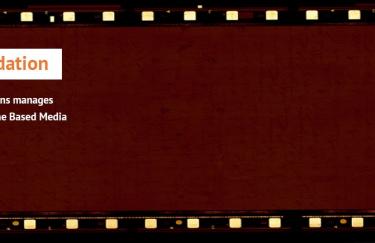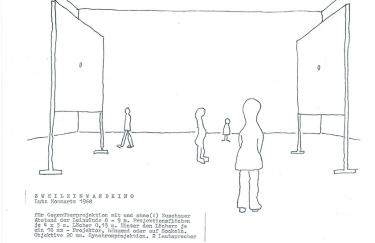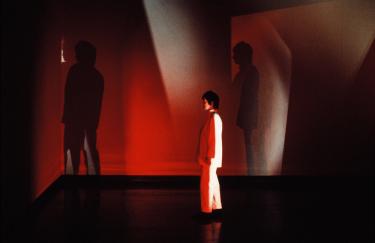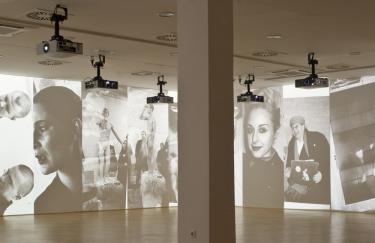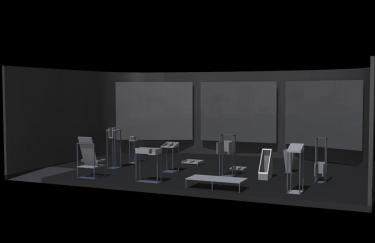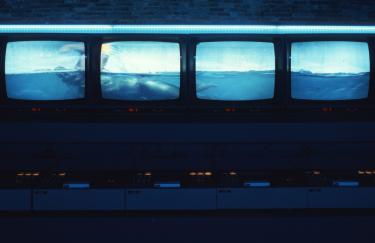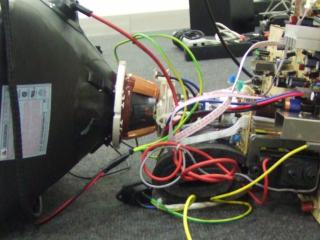
Case Study 2: Gary Hill, In Situ, 1986
as part of the exhibition Gary Hill: Strange Trajectories
Typ
Case studyDate
13.02.2007A very low, rectangular platform with a gray carpet marks the space of the installation. On a kind of television stand rests the chassis of a monitor with a screen that is too small for it. The video being replayed on it is a montage of television recordings about the Iran-Contra affair (1986) and video material shot for this purpose inspired the novel Thomas the Obscure by Maurice Blanchot.
Opposite the monitor stands a television easy chair with a cushion that is too small. A chassis with two fans has been placed on the floor between the monitor and the easy chair. Two more fans are installed in column-like elements at the four corners and face the center. Hanging in the middle of the ceiling is a paper feeder that was custom made for the installation that ejects sheets of paper in a predetermined sequence. The A4-format sheets are printed on both sides with stills from the video and numbered. They drop precisely when the corresponding image is seen on the screen. As they fall, the copies are whirled by the fans so that the viewer on the easy chair is exposed to a “storm of images.” The monitor, the paper feeder, the fans, and the speakers are controlled by signals on one of the soundtracks of the video. The cycle lasts around seventeen minutes. Then the paper feeder has to be filled manually again with a set of photocopies.
The first presentation of the work In Situ was in 1986 as part of the National Video Festival of the American Film Institute (AFI). The various elements of the installation were placed directly on the existing floor in a diagonal orientation. In all of the following presentations, by contrast, they were installed on a low platform with a carpet, which clearly distinguishes the space of the work from the rest of the space.
-
What role does the venue play in the installation?
-
How should the title, In Situ, be understood in that context?
-
Which presentation should provide orientation for a reinstallation?
-
What aspects of the installation are indispensable to its authenticity?
-
By what criteria should the components of the installation (carpet, easy chair, monitors, etc.) be selected? What role does the tube monitor play?
-
Can it be replaced by a flat-screen monitor?
-
What score is used to control the various elements of the installation?
Data Storage:
The original U-Matic tape was conserved and also transferred to DVD for the presentation at IMAI.
Easy Chair:
According to Gary Hill, an easy chair in the style typical of the 1960s should be used for the installation. For the re-presentation in Düsseldorf, such an easy chair was modified specially according to the artist’s instructions. It was upholstered in gray and the cushion was reduced in size.
Re-Presentation:
The IMAI Foundation re-presented the installation In Situ and showed it in the Gary Hill solo exhibition Strange Trajectories (16 September–28 October 2007). The presentation in Düsseldorf was modeled not on the first presentation of the work in Los Angeles but on the form of the presentation that became established in other exhibitions.
Venue and Presentation:
Analysis of the history of the presentation of the installation and an interview with the artist indicated that it is necessary to create a demarcated space (“in situ”) with the platform and carpet. This “island” can in principle be built anywhere. The first presentation of In Situ in 1986 represented an adaptation to the specific circumstances of the situation there. Future presentations should be based on the presentations that followed it.
Monitor:
The small monitor in the oversized chassis should, according to Hill, evoke association with an eye. This is reinforced by a closeup of the artist’s eye as the beginning of the video. The tube monitor with its characteristic curved form should not be replaced by a flat screen in the future because the association with the eye would be lost. Hill does not entirely rule out an alternative to the tube monitor if it is curved in this way. As soon as specific technical alternatives are possible, they should be assessed art historically.
Score:
The artist defines In Situ as a "system performance," that is, a presentation directed by an electronic control system. The sequence and rhythm in which the various devices in the installation function that the artist placed on a soundtrack of the video. It is essential significance to the work and should be documented in writing.

